 Technology
Technology  Technology
Technology  Humans
Humans 10 Everyday Human Behaviors That Are Actually Survival Instincts
 Animals
Animals 10 Animals That Humiliated and Harmed Historical Leaders
 History
History 10 Most Influential Protests in Modern History
 Creepy
Creepy 10 More Representations of Death from Myth, Legend, and Folktale
 Technology
Technology 10 Scientific Breakthroughs of 2025 That’ll Change Everything
 Our World
Our World 10 Ways Icelandic Culture Makes Other Countries Look Boring
 Misconceptions
Misconceptions 10 Common Misconceptions About the Victorian Era
 Mysteries
Mysteries 10 Strange Unexplained Mysteries of 2025
 Miscellaneous
Miscellaneous 10 of History’s Most Bell-Ringing Finishing Moves
 Technology
Technology Top 10 Everyday Tech Buzzwords That Hide a Darker Past
 Humans
Humans 10 Everyday Human Behaviors That Are Actually Survival Instincts
 Animals
Animals 10 Animals That Humiliated and Harmed Historical Leaders
Who's Behind Listverse?

Jamie Frater
Head Editor
Jamie founded Listverse due to an insatiable desire to share fascinating, obscure, and bizarre facts. He has been a guest speaker on numerous national radio and television stations and is a five time published author.
More About Us History
History 10 Most Influential Protests in Modern History
 Creepy
Creepy 10 More Representations of Death from Myth, Legend, and Folktale
 Technology
Technology 10 Scientific Breakthroughs of 2025 That’ll Change Everything
 Our World
Our World 10 Ways Icelandic Culture Makes Other Countries Look Boring
 Misconceptions
Misconceptions 10 Common Misconceptions About the Victorian Era
 Mysteries
Mysteries 10 Strange Unexplained Mysteries of 2025
 Miscellaneous
Miscellaneous 10 of History’s Most Bell-Ringing Finishing Moves
10 Real Objects With Alleged Supernatural Powers
Human beings have always been fascinated with magic and myth. We like to believe that we might stumble on something that will make us extra special, be it alien parents or scientific experiments with unforeseen consequences. Sometimes, we like to believe that ordinary objects are imbued with supernatural powers that will heal the sick, curse wrongdoers, or bring people back from the dead.
History is littered with stories about these objects with supernatural powers. Often, the romance of the story is enough to keep people believing, despite there being little or no evidence to prove it.
10 Drake’s Drum
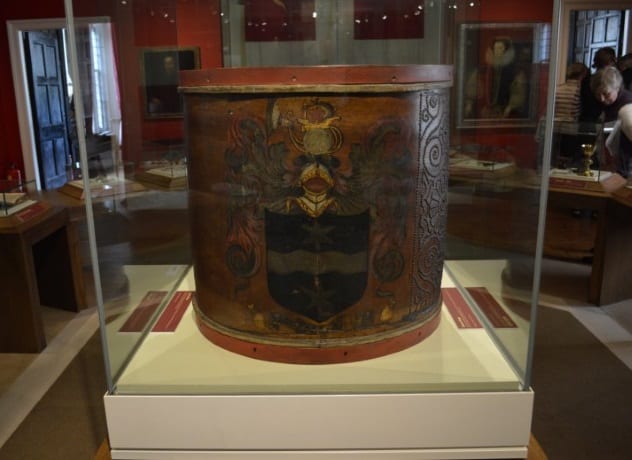
Sir Francis Drake was an explorer, adventurer, slaver, and pirate. He died of dysentery in 1596 off the coast of Panama, and his remains were buried at sea.
His effects, however, were sent to his childhood home of Buckland Abbey. Among his possessions was a small leather snare drum, of the sort that would have been beaten to signal an attack. The drum is not thought to have had any particular significance to Drake. However, along with the drum came a story. It is said that when England is in peril, the drum will beat of its own accord as a warning. And, should anyone beat on the drum to call him home, Francis Drake will return from his watery grave to protect his country.
There have been several reports of the drum beating of its own accord. Napoleon is said to have heard it when he was brought into the nearby harbor. It is said to have sounded at the outbreak of World War I and during the evacuation of Dunkirk. It is also said that when the German navy surrendered in 1918, they heard a drum beating, though there was no drum aboard the ship. Whether this was Drake’s Drum or some other supernatural musical instrument is unclear.[1]
Recent attempts to remove a replica of the drum from Buckland Abbey were strongly opposed, which is just as well, because the legend also says that if the drum is removed from the abbey, England will fall. Better to be safe than sorry.
9 Busby’s Stoop Chair
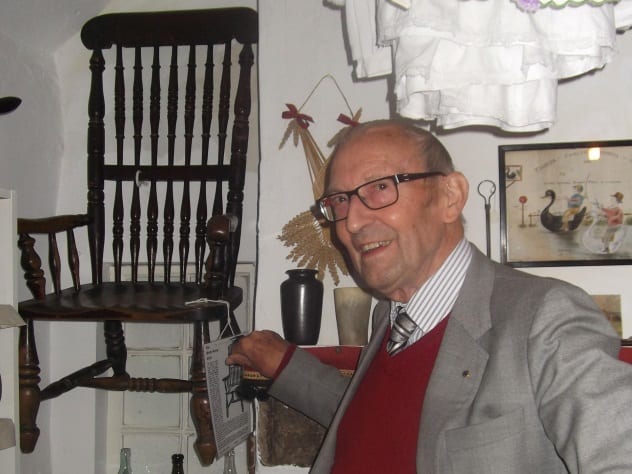
Thomas Busby was an unpleasant man. He drank too much and was often violent. In 1702, he was convicted of the murder of his father-in-law and, according to custom, was hanged and then gibbeted at a crossroads. His corpse was directed to be suspended from the gibbet (or “stoop,” as it was known in the local dialect) until it decayed.
Near the stoop was a roadside inn. It soon became known as Busby’s Stoop Inn. The inn was said to be haunted by Busby’s ghost. In particular, Busby appears to take exception to people sitting in one particular chair. World War II pilots, stationed nearby, thought the chair was unlucky, and several fatal accidents in the 1970s appear to have happened to people who’ve dared to sit in the chair.
In 1978, the landlord of the inn, out of concern for his patrons, and maybe in order to attract more of them, donated the chair to a local museum with the condition that no one should ever be allowed to sit in it. Despite regular offers from ghoulish buyers who want to purchase the chair and sensation-seekers who want to sit in it, the museum has refused to sell. The chair is on permanent display, suspended from the wall.
Thomas Busby’s reign of terror appears to be over.[2]
8 The Nanteos Cup
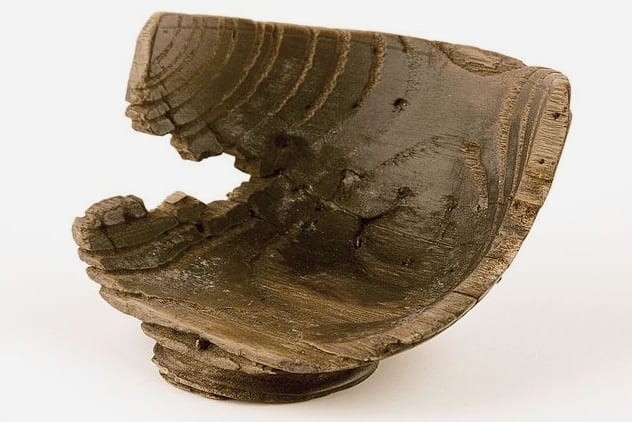
The Nanteos Cup, considered by some to be the Holy Grail, is a wooden cup (or, more precisely, the remains of what used to be a wooden cup). Originally kept at Strata Florida Abbey in Wales, the cup is now on permanent display at the National Library of Wales.[3]
The cup has long been believed to have the power to heal. The cup’s poor condition is probably due to the habit of lending it to the sick, the lame, and the dying. No charge was made for the loan of the cup, though borrowers were required to leave their most valuable asset as a deposit to ensure its return.
The cup was stolen in 2014 but returned safely via an anonymous source a year later. It is not known whether the thieves took the cup for its mystical properties, though police might have considered investigating anyone who had recently made a miraculous recovery.
7 The Hand Of Glory
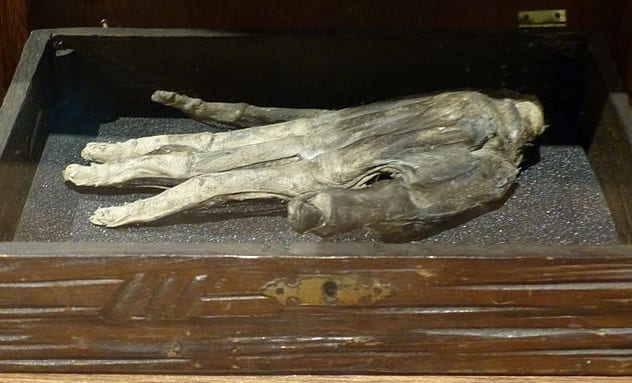
Whitby Museum in Yorkshire, England, holds the mummified remains of a human hand, known as a Hand of Glory. The Whitby Hand was discovered in the early 20th century hidden inside the wall of an ancient thatched cottage, and it is thought to be the last example in existence.
Supposedly formed from the pickled right hand of a convicted criminal, cut from the gallows while the body was still fresh, the Hand of Glory can be used as a candle by burglars, with the fingers being dipped in special wax and set alight. If a finger refused to catch fire, it meant that someone in the household was awake. The light cannot be extinguished by water or pinching but only by being doused in blood or blue milk. And where are you going to find blue milk?[4]
The hand was not only a perpetual source of light, but it was also cheaper than paying a lookout, which could be useful.
If you fancy making your own Hand of Glory, and you have the right arm of a recently executed felon at hand, you will need to wrap the hand in a winding sheet, squeeze out the blood, and put it in a clay pot, adding saltpeter, salt, and pepper (for flavor, presumably). Leave it for two weeks, and then expose it to the sun “in the dog-days.” If you are not experiencing dog-days, you could dry it in an oven lined with ferns. Next (and this bit might be tricky), you need to make the candle wax from the fat of a hanged man, virgin wax (not from an actual virgin), and Lapland sesame (an oil from a plant now extinct).
Oh well. You could always use a torch.
6 John Dee’s Crystal
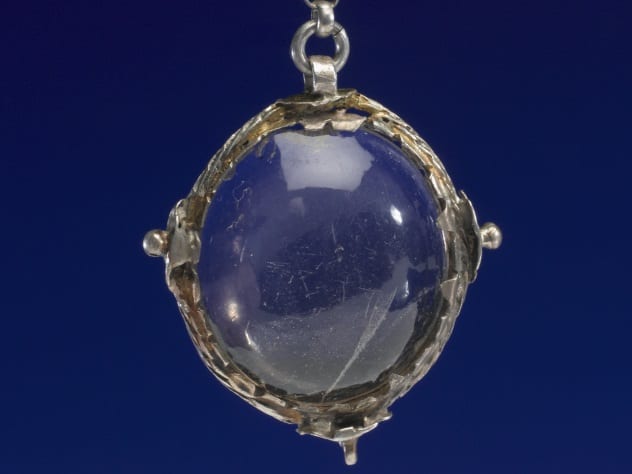
John Dee was an advisor to Queen Elizabeth I on astrological and scientific matters. He was also a mathematician and fancied himself as a bit of a doctor. Oh, and he talked to angels.
He communicated with these angels with a special mirror, which he termed his “scrying mirror,” and the angels obviously liked him, because in 1582, according to Dee, the angel Uriel (the fourth archangel and the angel of repentance), gave him a present—a large, purple crystal.
Dee used his crystal in order to predict the future. (What else would you do with it?) The crystal was passed to his son, who gave it to his doctor, Nicholas Culpeper. Culpeper used the stone in his medical practice, saying that the crystal could heal his patients. However, Culpeper stopped using the stone after a “demonic spirit” emerged from it.[5]
The crystal was bought by the Wellcome Trust in 1937 and remains in their collection. It is not known if they have benefited from its magical properties.
5 The Apotropaic Bull’s Heart
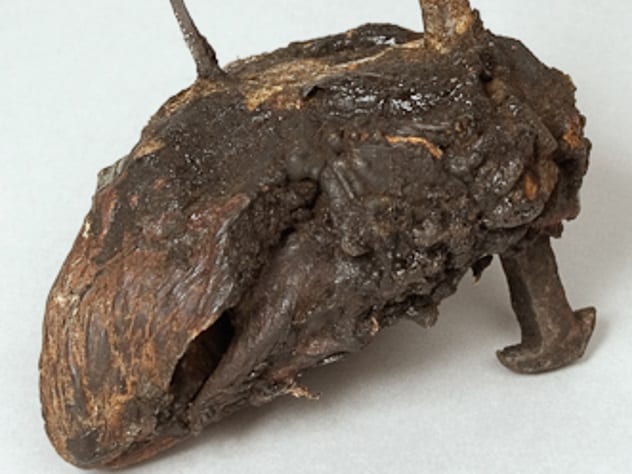
In 1892, a chimney sweep must have been surprised when he discovered a bull’s heart hanging inside a chimney. He must have been even more surprised when he realized that the heart was speared with large nails and thorns. Not only that, but next to the heart was a toad, which was also skewered with thorns.
Both objects were thought to have apotropaic properties. That is, they could ward off evil spirits. The idea was that the heart would shrivel in the smoke so that the evil-wisher would shrivel away, too. Perfectly logical.[6]
Many people believed that the chimney was an entry point for evil spirits, and many protective talismans were placed inside them. The pierced animal heart would have been used to punish a witch who had killed the householder’s cattle. The beast’s heart was cut out and impaled with “three-headed” iron nails before being hung inside the chimney to roast over a fire made of ash wood (well-known for its anti-witch properties). The smoked heart would then be left in the chimney to protect the home and farm, and the roasting of the heart would cause agonizing and eternal pain to the witch.
4 The Bell Of St. Mura
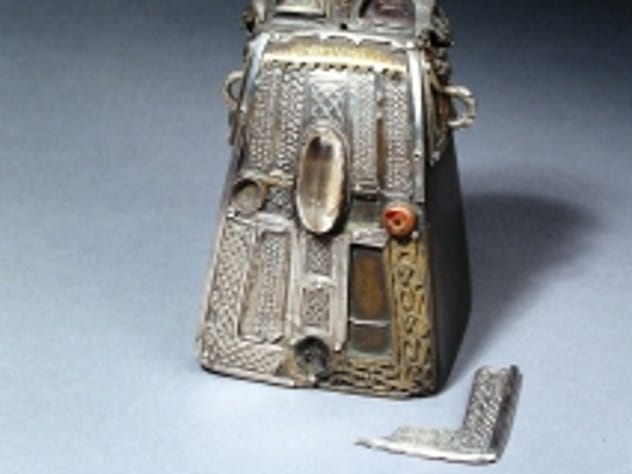
The Bell of St. Mura was, it is said, was brought to Earth by angels. The locals, attracted by its loud clanging, came running, whereupon the bell could be seen descending from the heavens. When the entire village had assembled before it, the bell stopped ringing, and the clapper separated from the bell and returned to the heavens, leaving the silent bell behind.
It was concluded that such a heavenly bell was not meant to ring on Earth but be used for a more holy purpose. From that time on, the bell was used not to make annoying, jangly music but instead to alleviate human suffering, which is a blessing all round. Drinking from the upturned vessel is said to be an “infallible safeguard” against danger. It has been used to give women in labor pain-free deliveries and also to heal the sick.[7]
The Bell of St. Mura is now held in the Wallace Collection in London, but it is not known whether it still retains its healing properties.
3 The Witch’s Ladder
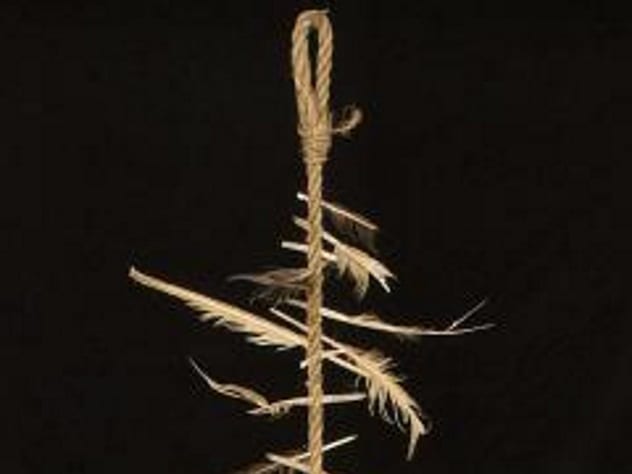
In 1911, the widow of a famous anthropologist donated items found in an attic to the Pitt Rivers Museum in Oxford. The objects included four brooms and a piece of string. The string was around 1.5 meters (5 ft) long, with a loop at one end. Feathers had been poked into the string along its length.
This was the only known example of a genuine witch’s ladder. The ladder was said to have belonged to an old woman, and thus a suspected witch, and was thought to be used for “getting away,” or stealing, the milk from her neighbor’s cows.
Unfortunately, nothing is known about how this worked, and though there is still speculation about the purpose of the ladder, aspiring witches today will probably find a trip to the supermarket a bit easier.[8]
2 The Delhi Purple Sapphire
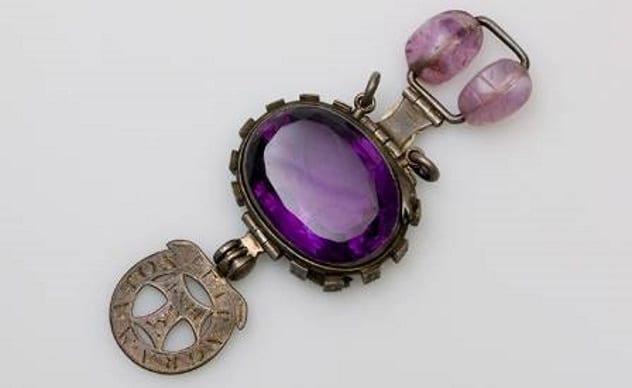
The Delhi Purple Sapphire is certainly a mysterious object, not least because, despite its name, it is actually an amethyst that came not from Delhi but from Kanpur, roughly 500 kilometers (300 mi) away. The stone was donated to the Natural History Museum in London in 1944 by the daughter of Edward Heron-Allen. It was encased in seven boxes.
When the last box was opened, the note that accompanied it, written by Edward Heron-Allen, ensured that the sapphire/amethyst would become a star attraction. The letter addressed the reader “in mourning.” The stone, it said, was terribly cursed and stained with the blood and dishonor of everyone who had owned it. Heron-Allen alleged that the stone had been looted from the Temple of the God Indra during the Siege of Kanpur and had caused at least three deaths as well as financial misfortune to its owners. It had even caused a renowned singer to permanently lose her voice.
Heron-Allen tried to throw the stone away, but it was returned to him. He felt compelled to keep it until his death, locked safely in a secure bank vault, and he left instructions that the stone should then be given away, along with his letter, and that his daughter must never be allowed to touch it.
He finished the letter by saying, “My advice [ . . . ] is to cast it into the sea. I am forbidden by the Rosicrucian Oath to do this, or I would have done it long ago.”[9]
Whether the jewel is actually cursed is up for debate. No one has worn it since, though it is still on display in the Natural History Museum.
1 The Munlochy Clootie Well

Munlochy lies on the Black Isle in the far north of Scotland. It is famous chiefly for its clootie well. There are several clootie wells in Scotland. They are built over natural springs, almost always with one or more trees growing beside them. The Munlochy well is also thought to have had a chapel beside it at one time.
A clootie is a strip of cloth which is tied around the branches of the clootie tree. The well at Munlochy dates back to pre-Christian times, when spirits were said to inhabit the well. The Munlochy clootie well is supposed to be inhabited by the spirit of St. Boniface. The clooties tied around the tree were supposed to honor the spirit that inhabited the well.
The clooties would be dipped into the well. Sick people often sucked the water from the cloth strips before tying them around the tree, as the water had healing powers, or they sometimes washed an injured area with the rag. Those who had suffered misfortune made a pilgrimage to the clootie well in the hopes of changing their luck.
However, the wells are not completely benevolent. It is said that anyone removing a clootie from a clootie well will succumb to the very misfortunes the person who placed it there was trying to overcome.[10]
You have been warned!
Ward Hazell is a writer who travels, and an occasional travel writer.
Read about more items with paranormal reputations on Top 10 Creepy Cursed Objects and Top 10 Cursed And Haunted Household Items.








